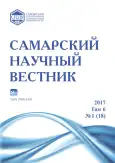Ural-Caspian Region as a historical and geographical phenomenon (XVI – the beginning of the XX century)
- Authors: Lyubichankovskiy S.V.1, Lyubichankovskiy A.V.2,3
-
Affiliations:
- Orenburg State Pedagogical University
- Orenburg State University
- Steppe Institute of Russian Academy of Sciences
- Issue: Vol 6, No 1 (2017)
- Pages: 104-109
- Section: 07.00.00 – Historical Sciences and Archaeology
- URL: https://journals.rcsi.science/2309-4370/article/view/21650
- DOI: https://doi.org/10.17816/snv201761204
- ID: 21650
Cite item
Full Text
Abstract
This paper deals with cross-disciplinary historical and geographical research. The Ural-Caspian Region existing from the 16th century to the beginning of the 20th century is its main focus. The Assessment of new lands inclusion in the Russian civilization is carried out. The authors analyze the Ural-Caspian Region through assessment of dynamics of its cultural landscapes. The social processes happening in the region are characterized. The authors suggest considering the Ural-Caspian Region as a frontier, existing from the 16th century to the beginning of the 20th century. Ethno cultural space structure mosaicity, original culture of the Cossacks and the zone with special social conditions were characteristics of the Russian and Nogai cultures assimilation at the early stage of the development. The Orenburg Region with its «creeping-away» regional identity is the only outlier of the Ural-Caspian Region. In its population historical memory it is possible to find five spatial images of the Orenburg Region: «base to Central Asia», «citadel of "civilization"», «testing ground for reforms», «operation object with huge resources» and «the deaf province».
Full Text
##article.viewOnOriginalSite##About the authors
Sergey Valentinovich Lyubichankovskiy
Orenburg State Pedagogical University
Author for correspondence.
Email: svlubich@yandex.ru
doctor of historical sciences, head of Russian History Department
Russian Federation, OrenburgAlexey Valentinovich Lyubichankovskiy
Orenburg State University; Steppe Institute of Russian Academy of Sciences
Email: av-lubichan@yandex.ru
candidate of geographical sciences, researcher, associate professor of Geography and Region Studies Department
Russian Federation, OrenburgReferences
- America's Frontier Story. A Documentary History of Westward Expansion. Huntigton, Princeton, 1980. 314 p.
- Замятина Н.Ю. Зона освоения (фронтир) и её образ в американской и русской культурах // Общественные науки и современность. 1998. № 5. С. 12–18.
- Герасименко Т.И. Этногеографический атлас Оренбургской области. Оренбург: ИПК ГОУ ОГУ, 2015. 80 с.
- Трепавлов В.В. История Ногайской Орды. М.: Восточная литература, 2002. 752 с.
- Илишкин М.Г. Участие ойрат-калмыков в политической истории Тибета [Электронный ресурс] // Буддизм в Калмыкии. – http://buddhisminkalmykia.ru/ ?p=391.
- Карамзин Н.М. История государства Российского. Т. 10. СПб.: Дм. Буланин, 2010. 319 с.
- Кривощеков А.И. Исторические судьбы Оренбургского края // Вестник Оренбургского учебного округа. 1912. № 2. С. 87–115.
- Мацузато К. Управляя пространством // Местное управление в пореформенной России: механизмы власти и их эффективность. Сводные материалы заочной дискуссии / под ред. А.Е. Загребина, С.В. Любичанковского. Екатеринбург-Ижевск: Изд-во УрО РАН, 2010. 496 с.
- Добросмыслов А.И. Материалы по истории России. Сборник указов и других документов, касающихся управления и устройства Оренбургского края. Т. 1–2. Оренбург: Губ. типография, 1900.
- Смирнов Ю.Н. Оренбургская экспедиция (комиссия) и присоединение Заволжья к России в 30–40-е гг. XVIII века. Самара: Изд-во «Самарский ун-т», 1997. 187 с.
- Семенов В.Г. Губернаторы Оренбургского края. Оренбург: Оренбургское книжное издательство, 1999. 400 с.
Supplementary files






